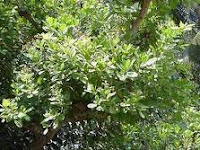Jackfruit or Kathal in Urdu is a member of the mulberry family of trees and fruit. It is distantly related to figs and more closely to breadfruit. It is no relation to durian, although it looks a lot like it when it is growing. It is one of those fruits that you either love or hate, but once you get past the initial reaction to the smell of the whole fruit - similar to rotting onions, and eat the fleshy fruit, you will either love it as we do, or hate it and have an adverse reaction which may cause some discomfort in the back of the throat and tongue for 15 to 20 minutes.
It is the biggest fruit that grows on trees and can be up to three feet long, and weigh up to 80 pounds. It looks a lot like the durian, but the outer skin is less spiky and the smell is different- durian smells like old socks. You have to slit the fruit open to get at the fleshy pieces which are probably best eaten fresh; although in India they are used in curries and stews and can be pickled.
Jackfruit is indigenous to Sri Lanka, China and Malaysia, but has been cultivated in India for at least 3000 years. The Bangladeshis have taken it as their national fruit, but in Pakistan it is grown in the Karachi area for its novelty value. The fruit can be bought in two markets there however, in the Empress market and the new Subzi Mandi.
Jackfruit trees can live for hundreds of years if cared for and take between 10 and 14 years to bear fruit. There are two varieties of jackfruit, one which is hard and the other soft. The hard one is cooked as a vegetable or eaten raw as is the softer one, which is used in salads and desserts.
 |
| Ripe Jackfruit |
The Chinese have used it for centuries in traditional medicine as the unripe fruit has astringent properties, the bark contains tannin and the ripe fruit is used as a general tonic and a mild laxative when ripe. The latex from the tree is mixed with vinegar and used to heal abscesses snake bites and a paste made from the leaves, mixed with coconut juice is good for all skin problems. The seeds are given to stop vomiting, but care should be taken with these as they should be boiled or roasted or boiled and then roasted if you want to eat them. In India they are eaten as you would eat lentils.
The bark is sometimes used in poultices to treat wounds and swellings, and the heated leaves are also put on wounds to stop bleeding. The wood when boiled has sedative properties, and the pith is said to induce abortion. An extract of the root is used for fevers and to treat diarrhoea and it is also used for skin problems and to treat asthma.
The fruit rind contains pectin and makes a good jelly when used with citric acid. The leaves of the tree are used for animal fodder as well as food wrappings, and can be sewn together to make plates. The wood is resistant to termites and is prized in furniture- making in Sri Lanka, where they also use the roots of old trees to make picture frames and to carve decorative items from. The latex can be used as a cement or sealant to caulk boats, mend holes in buckets, and to stick pieces of crockery and earthenware together when they break.
 |
| Jackfruit Tree |
The fruit inside the Jackfruit has simple sugars, fructose and sucrose which give you an almost immediate energy boost, and it is rich in dietary fibres which means that it is a good bulk laxative and helps protect against colon cancer and piles. It is rich in vitamin A which is necessary to maintain good eyesight, and as it is a powerful antioxidant it helps fight free radicals. It also contains beta-carotene and lutein, antioxidants which protect against breast and prostate cancer as well as other types of cancer. The fruit is also rich in B-complex vitamins (niacin, thiamin, riboflavin and folic acid), B6 (pyridoxine) and vitamin C. The seeds contain protein and minerals. However medical trials have suggested that the seeds can lower libido and induce temporary erectile dysfunction, and it is not advisable for pregnancy or breast-feeding mothers to eat the seeds.
There is insufficient medical evidence to support the traditional uses of the jackfruit, but the studies that have been carried out suggest that perhaps the leaves can treat high levels of blood sugar and glucose intolerance. Other studies suggest that the sees may have antimicrobial, anti-viral and immuno-stimulant properties, but more studies are needed to prove or disprove these initial findings, especially for the importance of the jackfruit in treating diabetes.
JACKFRUIT SALAD
Ingredients
1 jackfruit, inner fruits removed and sliced
6-8 bananas, sliced
2 tbsps honey
Garnish- mint leaves
Method
Mix the ingredients together and serve.
Garnish with mint leaves.
This has Taste and is a Treat.

































